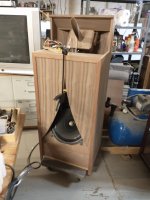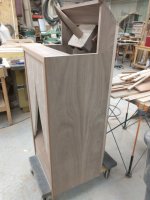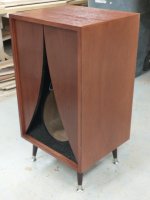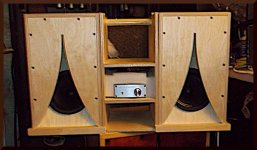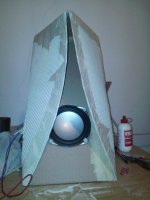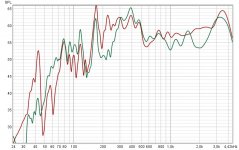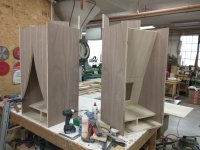I didn't put any photos because I thought that THE first step is to post THE graph and judge the result based on that. I'll post the photos as soon as possible. I can anticipate that the exponential curve front walls are not parallel with the rear one
Hi Suntiger - so that amazing looking enclosure is a "hybrid" of BLH with horn mouth exiting behind the K-tube with a K15 front K-coupler ? - Pretty Wild !!!!! What size is the K-tube and what are the drivers? Did you design/build it? I'm looking for input on making a K6.5 midrange coupler which will no only sound good but measures reasonably well.
It would stack on my "Kube12" or "Kube15"
I'm also always interested in small 2.1 K systems for impact without bulk. I'm on a dinky K3.5 with #40 Kinter 2.1 3118 amp as my system these days in decrepit old age ;^)
It would stack on my "Kube12" or "Kube15"
I'm also always interested in small 2.1 K systems for impact without bulk. I'm on a dinky K3.5 with #40 Kinter 2.1 3118 amp as my system these days in decrepit old age ;^)
arivel
k15 is pretty well known and a good performer - especially in the subjective sense. I think if the front shelf were removed a hole in the 200Hz region would deepen. The front chamber's depth could be be a few inches less when removing the front shelf. A curved reflector per patent 3540544 may help. I would say for external dims ` 36 inch height by 22.5 wide by 16 inches deep for a 15K with curved panel
.Your graph needs to have its vertical grid constrained to see more detail. For a given bulk versus bass reflex, a traditional Karlson cabinet will: be tuned higher - have a higher cutoff than the reflex - exhibit more "hit" than a reflex (not always and can be too much for accuracy) it slike the low frequency is set by the rear chamber and system tuning. A bandpass box simulation should be close for the low end. Since the front chamber tapers in volume as the slot goes to full cabinet width , not all the "volume" of the front chamber is active so there must be some fudge factor when using bandpass simulation to get a fit with reality.. Shape factor of the front chamber may play some part.
It is my invention. The K tube is 2"x10.5" and is backed by an Emilar 2" driver. The woofer is an Audio Nirvana 15" coax that I added a phase plug diverter to. I have had good luck with the K 12 also, and a whimsical little boom box, actually not that little.Hi Suntiger - so that amazing looking enclosure is a "hybrid" of BLH with horn mouth exiting behind the K-tube with a K15 front K-coupler ? - Pretty Wild !!!!! What size is the K-tube and what are the drivers? Did you design/build it? I'm looking for input on making a K6.5 midrange coupler which will no only sound good but measures reasonably well.
It would stack on my "Kube12" or "Kube15"
I'm also always interested in small 2.1 K systems for impact without bulk. I'm on a dinky K3.5 with #40 Kinter 2.1 3118 amp as my system these days in decrepit old age ;^)
I'm really loving the K tubes, they work! Why use horns if you don't need the volume increase?
Attachments
what does it mean ?explain yourself betterarivel
.Your graph needs to have its vertical grid constrained to see more detail.
Suntiger - you are one brave K experimenter - that's the spirit. I think K-tubes sound great when the low frequency enhancement of a horn isn't needed.
What's in your boombox??
here's one done for me by Jesse Brunner some years back. Mice got into it and everything so have to redo its innards. Its a carrier so the speakers could be separated.
What's in your boombox??
here's one done for me by Jesse Brunner some years back. Mice got into it and everything so have to redo its innards. Its a carrier so the speakers could be separated.
Attachments
Suntiger -
Your K- with internal K-tube - is that a K12? If so does it have the 10 degree upper panel which can work with a K-tube? An internal; tube per Karlson's X15 is a tidy way to do things and from the examples I've heard , pretty good sound.
https://www.diyaudio.com/community/attachments/img_20220320_224158727-jpg.1126104/
Your K- with internal K-tube - is that a K12? If so does it have the 10 degree upper panel which can work with a K-tube? An internal; tube per Karlson's X15 is a tidy way to do things and from the examples I've heard , pretty good sound.
https://www.diyaudio.com/community/attachments/img_20220320_224158727-jpg.1126104/
Is the graph okay?
as you can see from the photographs, it is not the inner reflector that is curved but the front outer walls with the exponential aperture.
as you can see from the photographs, it is not the inner reflector that is curved but the front outer walls with the exponential aperture.
Attachments
the graphs look very well taken - you can see some losses in the 200Hz are and ripple. above with improvement below 100Hz. In patent 3540544 Karlson shows Fig.6 and Fig.8 curved. XRK971 bent the front walls "the other way" and said it improved sound quality.

The challenge is to understand what the hole causes around 200 Hz causes.
Have you seen somewhere a graph in which there is no hole?
Have you seen somewhere a graph in which there is no hole?
In a regular Karlson, I think the backwave from the inner port can partially fill in the hole.
For a commercial Karlson, Acoustic Control's 115BK has very little dip. If it were scaled 1.2X in size then it be the bulk of K15. Whether it would still be as smooth = ? until built and measured.
My 41.5 inch tall K18 measures reasonably smooth with an EVM18B speaker which had low moving mass for an 18" driver. The hole in its response I think is from the parallel side-walls. It is very clear and powerful and has a curved upper reflector.
If built aagain I would shorten the height to around 36 inches



For a commercial Karlson, Acoustic Control's 115BK has very little dip. If it were scaled 1.2X in size then it be the bulk of K15. Whether it would still be as smooth = ? until built and measured.
My 41.5 inch tall K18 measures reasonably smooth with an EVM18B speaker which had low moving mass for an 18" driver. The hole in its response I think is from the parallel side-walls. It is very clear and powerful and has a curved upper reflector.
If built aagain I would shorten the height to around 36 inches
The boombox has a pair of Diatone 4" and an 8" sub in the back. It's run with a 3 channel class D Bluetooth amp.Suntiger - you are one brave K experimenter - that's the spirit. I think K-tubes sound great when the low frequency enhancement of a horn isn't needed.
What's in your boombox??
here's one done for me by Jesse Brunner some years back. Mice got into it and everything so have to redo its innards. Its a carrier so the speakers could be separated.
Yes it's a K-12 with internal K-tube with a B&C DE-50 driver and a Goodmans vintage C-100 coax. Great sounding smallish package. It was a project for a client. It has the angled panel with horizontal slots.Suntiger -
Your K- with internal K-tube - is that a K12? If so does it have the 10 degree upper panel which can work with a K-tube? An internal; tube per Karlson's X15 is a tidy way to do things and from the examples I've heard , pretty good sound.
https://www.diyaudio.com/community/attachments/img_20220320_224158727-jpg.1126104/
There's a Karlson with a University 312 on Craigslist close to me. Is that a good combination? Not sure if it's a K12 or K15.
Wow love the enclosure do you have build pics or plans for making it thanks if you canHere's a K-15 inside a Jensen Imperial type enclosure. No box resonance because it's a horn. Great open uncolored sound.
It's a Jensen PR-100 narrowed to 22" and the basic K-15 inside. There are various tweaks. I don't have plans, I just build stuff. I'm in the Chicago area.Wow love the enclosure do you have build pics or plans for making it thanks if you can
Attachments
hey suntiger - what would you suggest for a K-midrange for a 6.5" speaker? I'd like to have a strong midrange module to stack on larger K. Not much gets done as away from home plus plain old w. kidney C - heart kaput - etc.
http://www.loudspeakerdatabase.com/LaVoce/MAF061.50
http://www.loudspeakerdatabase.com/LaVoce/MAF061.50
Freddi
I have an intuitive vision of a small Karlson slotted baffle in a U frame as an open baffle sitting on the K-15. That way you get the frequency balancing and dispersion benefits without the added cabinet resonance. I would try just setting the driver back an inch or two and not slant it back.
I just kind of see these designs and then build prototypes. Remarkably they usually work, tweaking notwithstanding.
I have an intuitive vision of a small Karlson slotted baffle in a U frame as an open baffle sitting on the K-15. That way you get the frequency balancing and dispersion benefits without the added cabinet resonance. I would try just setting the driver back an inch or two and not slant it back.
I just kind of see these designs and then build prototypes. Remarkably they usually work, tweaking notwithstanding.
- Home
- Loudspeakers
- Full Range
- Karlson
